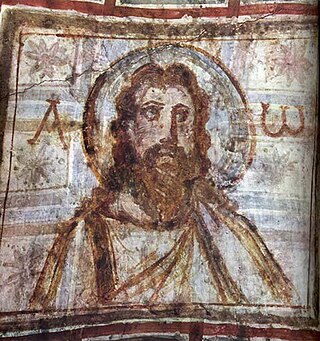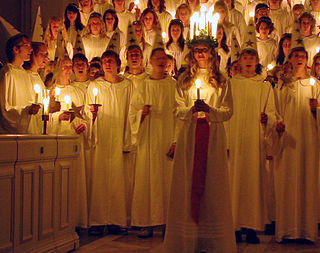Ælfheah, more commonly known today as Alphege, was an Anglo-Saxon Bishop of Winchester, later Archbishop of Canterbury. He became an anchorite before being elected abbot of Bath Abbey. His reputation for piety and sanctity led to his promotion to the episcopate and, eventually, to his becoming archbishop. Ælfheah furthered the cult of Dunstan and also encouraged learning. He was captured by Viking raiders in 1011 during the siege of Canterbury and killed by them the following year after refusing to allow himself to be ransomed. Ælfheah was canonised as a saint in 1078. Thomas Becket, a later Archbishop of Canterbury, prayed to Ælfheah just before his murder in Canterbury Cathedral in 1170.

Jerome, also known as Jerome of Stridon, was an early Christian priest, confessor, theologian, translator, and historian; he is commonly known as Saint Jerome.

Catacombs are man-made subterranean passageways for religious practice. Any chamber used as a burial place is considered a catacomb, although the word is most commonly associated with the Roman Empire.

A veil is an article of clothing or hanging cloth that is intended to cover some part of the head or face, or an object of some significance. Veiling has a long history in European, Asian, and African societies. The practice has been prominent in different forms in Judaism, Christianity, and Islam. The practice of veiling is especially associated with women and sacred objects, though in some cultures, it is men, rather than women, who are expected to wear a veil. Besides its enduring religious significance, veiling continues to play a role in some modern secular contexts, such as wedding customs.

Richard Wayne Mullins was an American contemporary Christian music singer and songwriter best known for his worship songs "Awesome God" and "Sometimes by Step". Some of his albums were listed by CCM Magazine in their ranking of the 100 Greatest Albums in Christian Music, including A Liturgy, a Legacy, & a Ragamuffin Band (1993) at No. 3, The World As Best As I Remember It, Volume One (1991) at No. 7, and Winds of Heaven, Stuff of Earth (1988) at No. 31. His songs have been performed by numerous artists, including Caedmon's Call, Five Iron Frenzy, Amy Grant, Carolyn Arends, Jars of Clay, Michael W. Smith, John Tesh, Chris Rice, Rebecca St. James, Hillsong United and Third Day. During the tribute to Rich Mullins' life at the 1998 GMA Dove Awards, Amy Grant described him as "the uneasy conscience of Christian music.”

A mantle is an ecclesiastical garment in the form of a very full cape that extends to the floor, joined at the neck, that is worn over the outer garments. Especially in the case of Elijah, it was likely a tallit, a Hebrew garment that housed the fringes still seen today which are also translated at “the hem of His garment” in the New Testament. It is also likely that further ecclesiastical garments were based originally on this one.

Olaf II Haraldsson, later known as Saint Olaf and Olaf the Holy, was King of Norway from 1015 to 1028. Son of Harald Grenske, a petty king in Vestfold, Norway, he was posthumously given the title Rex Perpetuus Norvegiae and canonised at Nidaros (Trondheim) by Bishop Grimketel, one year after his death in the Battle of Stiklestad on 29 July 1030. His remains were enshrined in Nidaros Cathedral, built over his burial site. His sainthood encouraged the widespread adoption of Christianity by Scandinavia's Vikings/Norsemen.

The depiction of Jesus in pictorial form dates back to early Christian art and architecture, as aniconism in Christianity was rejected within the ante-Nicene period. It took several centuries to reach a conventional standardized form for his physical appearance, which has subsequently remained largely stable since that time. Most images of Jesus have in common a number of traits which are now almost universally associated with Jesus, although variants are seen.

A candy cane is a cane-shaped stick candy often associated with Christmastide, as well as Saint Nicholas Day. It is traditionally white with red stripes and flavored with peppermint, but the canes also come in a variety of other flavors and colors.

Lucia of Syracuse (283–304), also called Saint Lucia was a Roman Christian martyr who died during the Diocletianic Persecution. She is venerated as a saint in Catholic, Anglican, Lutheran, and Eastern Orthodox Christianity. She is one of eight women explicitly commemorated by Catholics in the Canon of the Mass. Her traditional feast day, known in Europe as Saint Lucy's Day, is observed by Western Christians on 13 December. Lucia of Syracuse was honored in the Middle Ages and remained a well-known saint in early modern England. She is one of the best known virgin martyrs, along with Agatha of Sicily, Agnes of Rome, Cecilia of Rome and Catherine of Alexandria.

Daphni or Dafni is an eleventh-century Byzantine monastery eleven kilometers northwest of central Athens in the suburb of Chaidari, south of Athinon Avenue (GR-8A). It is situated near the forest of the same name, on the Sacred Way that led to Eleusis. The forest covers about 18 km2 (7 sq mi), and surrounds a laurel grove. "Daphni" is the modern Greek name that means "laurel grove", derived from Daphneion (Lauretum).

Saint Lucy's Day, also called the Feast of Saint Lucy, is a Christian feast day observed on 13 December. The observance commemorates Lucia of Syracuse, an early-fourth-century virgin martyr under the Diocletianic Persecution. According to legend, she brought food and aid to Christians hiding in the Roman catacombs, wearing a candle lit wreath on her head to light her way, leaving both hands free to carry as much food as possible. Because her name means "light" and her feast day had at one time coincided with the shortest day of the year prior to calendar reforms, it is now widely celebrated as a festival of light. Falling within the Advent season, Saint Lucy's Day is viewed as a precursor of Christmastide, pointing to the arrival of the Light of Christ in the calendar on December 25th, Christmas Day.

Rose is the color halfway between red and magenta on the HSV color wheel, also known as the RGB color wheel, on which it is at hue angle of 330 degrees.

The race and appearance of Jesus, widely accepted by researchers to be a Judean from Galilee has been a topic of discussion since the days of early Christianity. Various theories about the race of Jesus have been proposed and debated. By the Middle Ages, a number of documents, generally of unknown or questionable origin, had been composed and were circulating with details of the appearance of Jesus. These documents are now mostly considered forgeries.

In chemistry, the CPK coloring is a popular color convention for distinguishing atoms of different chemical elements in molecular models.

The Gero Cross or Gero Crucifix, of around 965–970, is the oldest large sculpture of the crucified Christ north of the Alps, and has always been displayed in Cologne Cathedral in Germany. It was commissioned by Gero, Archbishop of Cologne, who died in 976, thus providing a terminus ante quem for the work. It is carved in oak, and painted and partially gilded – both have been renewed. The halo and cross-pieces are original, but the Baroque surround was added in 1683. The figure is 187 cm high, and the span of its arms is 165 cm. It is the earliest known Western depiction of Christ on the cross while dead; earlier depictions had Christ appearing alive.

Ewan Christian (1814–1895) was a British architect. He is most frequently noted for the restorations of Southwell Minster and Carlisle Cathedral, and the design of the National Portrait Gallery. He was Architect to the Ecclesiastical Commissioners from 1851 to 1895. Christian was elected A RIBA in 1840, FRIBA in 1850, RIBA President 1884–1886 and was awarded the Royal Gold Medal in 1887.

Christian symbolism is the use of symbols, including archetypes, acts, artwork or events, by Christianity. It invests objects or actions with an inner meaning expressing Christian ideas.
The Lutheran liturgical calendar is a listing which details the primary annual festivals and events that are celebrated liturgically by various Lutheran churches. The calendars of the Evangelical Lutheran Church in America (ELCA) and the Evangelical Lutheran Church in Canada (ELCIC) are from the 1978 Lutheran Book of Worship and the calendar of the Lutheran Church–Missouri Synod (LCMS) and the Lutheran Church–Canada (LCC) use the Lutheran Book of Worship and the 1982 Lutheran Worship. Elements unique to the ELCA have been updated from the Lutheran Book of Worship to reflect changes resulting from the publication of Evangelical Lutheran Worship in 2006. The elements of the calendar unique to the LCMS have also been updated from Lutheran Worship and the Lutheran Book of Worship to reflect the 2006 publication of the Lutheran Service Book.

The Head of Christ, also called the Sallman Head, is a 1940 portrait painting of Jesus of Nazareth by American artist Warner Sallman (1892–1968). As an extraordinarily successful work of Christian popular devotional art, it had been reproduced over half a billion times worldwide by the end of the 20th century. Enlarged copies of the work have been made for churches, and small pocket or wallet-sized prayer cards bearing the image have been mass-produced for private devotional use. The painting is said to have "become the basis for [the] visualization of Jesus" for "hundreds of millions" of people.















